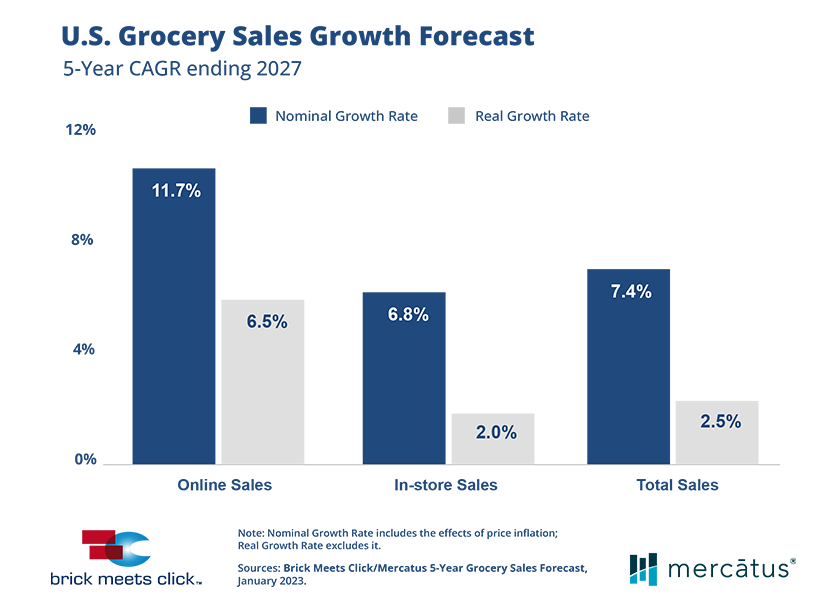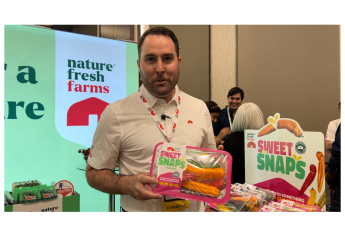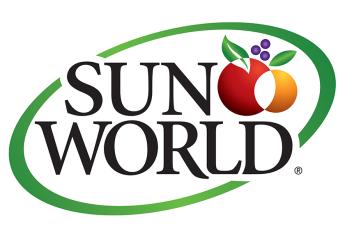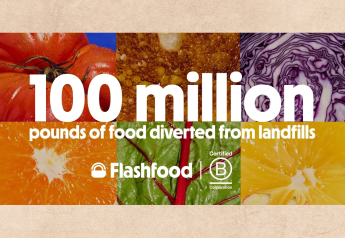New 5-year forecast: grocery sales slowdown, but growth in pickup

An aging U.S. population and declining household size could weigh down online and in-person grocery sales in the next five years.
U.S. online grocery sales are forecast to grow at a compound average growth rate of 11.7% in that time, increasing online’s share of overall grocery spending from 11.2% in 2022 to 13.6% in 2027, according to a news release from the 2023 Brick Meets Click/Mercatus 5-Year Grocery Sales Forecast.
Persistent price inflation, ongoing concerns about illnesses — such as COVID, RSV and the flu — and a maturing online segment are factors contributing to the outlook.
“This forecast reflects that the projected growth of online grocery sales is slowing after the significant gains of the last two-plus years,” Brick Meets Click partner David Bishop said in the release. “Now more than ever, grocers need a grounded view of the future market while simultaneously strengthening the customer experience to protect their base business and improving the profitability of this higher cost-to-serve mode of shopping.”
Inflation effect
Excluding the impact of price inflation, total grocery sales — or combined online and in-store sales — are projected to grow at a 2.5% compound average growth rate over the next five years, driven by a 1.7% increase in household spending and 0.8% gain in the number of households. An aging population and declining household size are weighing down both measures.
Related news: More than 50% of U.S. households ordered groceries online in December
Persistent grocery-related inflation is expected to continue at a five-year compound average growth rate of 4.8%, starting from 2022’s rate of 10.9% versus the prior year and tapering down to 2.8% by 2027.
The impact of this ongoing price inflation is not evenly distributed. Inflation fuels nearly three-quarters of the projected gains for in-store sales but accounts for less than half of the gains expected for online sales.
Health concerns drive the demand for online grocery to some degree, and this is likely to continue, according to the release. Concerns about contracting COVID-19 motivate about 10% of online grocery’s monthly active users, according to the October 2022 Brick Meets Click/Mercatus Grocery Shopping Survey. The recent rise of other respiratory illnesses, such as RSV and the seasonal flu, is also motivating customers to shop online for groceries.
Online-shopping receiving methods
In terms of online grocery segments, pickup sales are expected to grow at a five-year nominal compound average growth rate of 13.6% compared to 10.8% for delivery and 8% for ship-to-home. And pickup’s share of online grocery sales is forecast to expand from 45.4% in 2022 to 50.3% during 2027, at the expense of the other two segments.
Pickup is positioned to expand more than the other two receiving methods primarily because of expected increases in market availability. This is because a small portion of U.S. households lacks convenient access to any pickup service, and many U.S. grocery retailers are still in the process of rolling out pickup services across their base of stores, according to the release. In contrast, delivery is already saturated, with most customers having the choice of multiple home delivery options across a wide range of retail banners. Also, use of delivery is more sensitive than pickup to financial and health concerns.
Spending per order and order frequency
Spending per order and order frequency rates are both anticipated to increase but to varying degrees across the three online segments.
Average order values over the next five years are projected to grow at a compound average growth rate between 4.2% and 6.4% (inclusive of inflation) with ship-to-home coming in at the lower end, delivery in the mid-range, and pickup on the higher end. At the same time, order frequency among active users is anticipated to increase from 1.9% to 3.3%, again with ship-to-home at the lower end, delivery in the mid-range, and pickup on the higher end.
“When it comes to achieving online channel profitability, my advice to grocery retailers is: Work smarter, not harder, and focus on the fundamentals,” Mercatus President and CEO Sylvain Perrier said in the release. “Know who your customers are and the value you provide them. Use that insight to deliver a more personalized brand experience that is consistent and frictionless. Take steps to improve margins using simple tactics like offering lower cost pickup services, engaging with multiple third-party delivery providers, and leveraging first-party retail media to offset the cost to serve online customers.”
Check out the Brick Meets Click website for more insights from the forecast and information about the just released 2023 U.S. eGrocery Market Forecast report.







